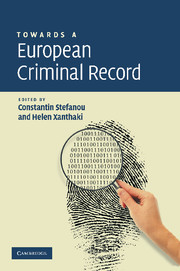Book contents
- Frontmatter
- Contents
- List of contributors
- Preface and acknowledgements
- 1 Introduction: How did the idea of a European Criminal Record come about?
- PART I
- PART II
- 5 The European Criminal Record in Austria
- 6 The European Criminal Record in the Czech Republic
- 7 The European Criminal Record in Germany
- 8 The European Criminal Record in Greece
- 9 The European Criminal Record in Hungary
- 10 The European Criminal Record in Ireland
- 11 The European Criminal Record in the Netherlands
- 12 The European Criminal Record in Slovenia
- 13 The European Criminal Record in Slovakia
- 14 The European Criminal Record in Spain
- 15 The European Criminal Record in England and Wales
- PART III
- 19 Conclusions
- Index
10 - The European Criminal Record in Ireland
Published online by Cambridge University Press: 13 July 2009
- Frontmatter
- Contents
- List of contributors
- Preface and acknowledgements
- 1 Introduction: How did the idea of a European Criminal Record come about?
- PART I
- PART II
- 5 The European Criminal Record in Austria
- 6 The European Criminal Record in the Czech Republic
- 7 The European Criminal Record in Germany
- 8 The European Criminal Record in Greece
- 9 The European Criminal Record in Hungary
- 10 The European Criminal Record in Ireland
- 11 The European Criminal Record in the Netherlands
- 12 The European Criminal Record in Slovenia
- 13 The European Criminal Record in Slovakia
- 14 The European Criminal Record in Spain
- 15 The European Criminal Record in England and Wales
- PART III
- 19 Conclusions
- Index
Summary
Introduction
The purpose of this Chapter is to examine the feasibility of a European database for convictions from the national perspective of Irish law. The existing legal framework for recording criminal convictions in Ireland is set out below.
Existing legal framework
Recording and maintenance of information about criminal convictions in Ireland
An Garda Síochána is the Irish national police force. There has been recent extensive legislative reform of the Garda with the passing of the Garda Síochána Act 2005. Records of criminal convictions have traditionally been held by An Garda Síochána, and not by the Department of Justice (now the Department of Justice, Equality and Law Reform). The management of the statutory Habitual Criminal Registry (which was later renamed the Dublin Criminal Registry) was devolved after Irish Independence to An Garda Síochána in 1929. In 1973, the Dublin Criminal Registry was amalgamated with the administratively instituted Criminal Records Office (Dublin) to form the current institution, the Garda Criminal Records Office. In 2000, a new computerised system for recording convictions and court outcomes (i.e. sentences, disposals under the Probation of Offenders Act etc.), was introduced. This computerised system is called PULSE (Police Using Leading Systems Effectively). In 2002, the Garda Central Vetting Unit was formed on an administrative basis, and it liaises with the Criminal Records Office where required.
The Garda Criminal Records Office now has computerised systems for the storage and retrieval of intelligence information.
- Type
- Chapter
- Information
- Towards a European Criminal Record , pp. 197 - 210Publisher: Cambridge University PressPrint publication year: 2008



